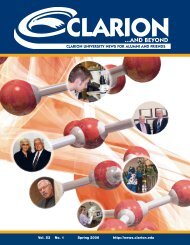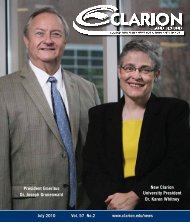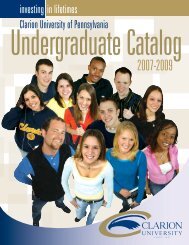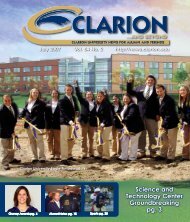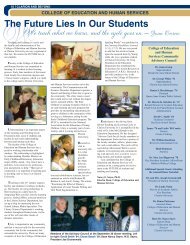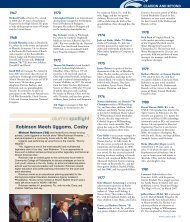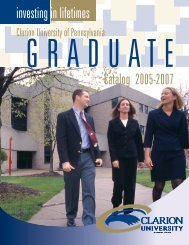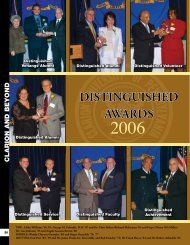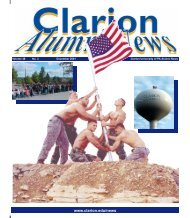Graduate - Clarion University
Graduate - Clarion University
Graduate - Clarion University
- No tags were found...
Create successful ePaper yourself
Turn your PDF publications into a flip-book with our unique Google optimized e-Paper software.
50 <strong>Clarion</strong> <strong>University</strong> of PennsylvaniaEducation/Reading/Science EducationSCED 554: Recent Advances in Sciences 3 s.h.Acquaints students with significant developments in the field of science that have taken place in the last two decades.Assumes a background of information in the fundamentals of the biological and physical sciences. Three lecture hours. Ondemand.SCED 555: History of Science 3 s.h.A study of the history of science with accent on the way in which broad scientific principles have developed and thosewho played a part. On demand.SCED 556: Research Grant Writing for Science Education 3 s.h.Covers topics to analyze, critique, and develop a research proposal. Students will study the methodology of research aswell as the mechanisms of obtaining external funding for their proposed projects. The students will develop problems, searchliterature, write rationales, critically evaluate each other’s work, and turn in a complete research or funding proposal. Spring,annually. May be repeated (as topics vary) up to six credits.SCED 560: Science Curriculum in the Middle and Junior High School 3 s.h.A course designed to acquaint students with modern science instructional strategies and curricula for the junior high/middleschool levels. Recent developments in curricular objectives, the unique physiological and psychological qualities of middlelevel students, science content, teaching strategies, and laboratories are stressed. Fall, annually.SCED 561: Modern Astronomy 1 s.h.Covers recent developments in astronomy which are not normally covered in a traditional astronomy course. Topics includestellar, evolution, pulsars, neutron stars, black holes, quasars, and supernovae. Summer, on demand.SCED 562: Topics in Cosmology 1 s.h.This short course deals in a non-mathematical manner with questions related to the universe as a whole-its beginning,geometry, present state and future development. Topics include the origin of the elements, expansion of the universe, geometryof the universe and observational evidence. Summer, on demand.SCED 563: Demonstrations and Projects in Astronomy 3 s.h.Emphasizes the selection and preparation of demonstrations and projects in astronomy for teachers of elementary andsecondary schools. Summer, on demand.SCED 566: Advanced Field Photography 3 s.h.Teaches in-service teachers how to use the advanced aspects of modern SLR 35mm camera and accessories to photographscience subjects in the field. Includes advanced techniques of close-up, telephoto, and photomacrography, as well as use ofadvanced depth of field, lighting, and composition. Students learn advanced techniques of photographing flora and fauna,geological, astronomical, meteorological, and ecological subjects. Students provide camera and film. Prerequisites: SCED466 or permission of instructor. Summer, on demand.SCED 567: Slide Program Development 3 s.h.This course is normally taken concurrently with SCED 466: Field Photography or SCED 566: Advanced Field Photography.It is designed to be taken by in-service teachers and will teach them how to put together short, single-concept slide programsto be used in their elementary or secondary science classrooms. The Karplus and Generative Models of teaching concepts willbe stressed for use with the program. Prerequisites: SCED 466 or SCED 566 or must be taken concurrently, or permission ofinstructor. Summer, on demand.SCED 570: Local School Curriculum Development in Science 3 s.h.Assists individual or groups of teachers with sufficient science background to develop, improve, or implement sciencecurricula for the elementary and secondary schools. Focuses on the production of curricular materials for actual use andevaluation. Permission of instructor. Each semester. May be repeated (as topics vary) for nine credits.SCED 571: Program for Improving Elementary Science (PIES) 3 s.h.PIES promotes effective science teaching and instructional leadership in science in the elementary school. In-serviceteachers, through hands-on investigations in the life, physical, and earth sciences, acquire knowledge of science, increase theirskills in using science process skills, and develop positive attitudes toward science. A similar course, SCED 471: Program forImproving Elementary Science, is offered for undergraduate, senior, elementary majors. On demand. Permission of instructorrequired.SCED 572: Program for Enhancing Educational Leadership in Science (PEELS) 1 s.h.PEELS involves elementary administrator/teacher teams in exemplary science experiences. Teams are instructed in scienceprocess skills, effective science teaching strategies, development of science program goals, and the application of scienceeducation research to elementary school science programs. Each team designs and implements an action plan which focuseson specific actions for the improvement of science in their own schools. On demand. Permission of instructor required.SCED 573: Creative Integration of Science in Elementary Education (CISEE) 3 s.h.CISEE helps in-service elementary teachers learn how to integrate science content and science-process skills with othersubject areas, including reading and language arts, math, social studies, physical education, art, music, and microcomputereducation. Emphasis on the use of hands-on investigations; teachers are required to design and implement lessons for theirown students which demonstrate the integration of science and other elementary curriculum areas. On demand. Permissionof instructor required.SCED 574: Science and Software for Elementary Teachers 2 s.h.Helps elementary teachers identify, select, and integrate science courseware appropriate for implementation into existingelementary school science curricula. Participants use exemplary science courseware to introduce, enhance, and reinforcerelated hands-on science activities. The culminating project for this course is the presentation of action research findingsrelated to the relationships between microcomputers and hands-on elementary school science. On demand. Permission ofinstructor required.



